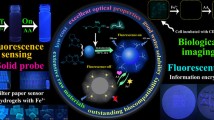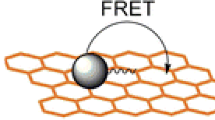Abstract
Glutathione and 2-aminopyridine are used as carbon sources to prepare carbon dots (CDs) by a one-step hydrothermal reaction. The results show that the average particle diameter of CDs is 8.64 nm with uniform size distribution and the fluorescence quantum yield is 13.62%. We further demonstrate that novel CDs possess highly selective sensing of Fe3+ from 0.2 to 200 μM with a low detection limit (0.194 μM). Meanwhile, the fluorescence of CDs can be repeated many times by the addition of S2−. Moreover, the CDs are used for biological imaging of living cells with well cell penetrability and low toxicity. Furthermore, it is successfully applied for anti-counterfeiting and information encryption. More interestingly, it can be doped with hydrogel and filter paper to prepare solid-phase sensors exhibiting high sensitivity and fast response, demonstrating their tremendous potential for the simple, rapid, and low-cost monitoring of Fe3+ and S2−.
Graphical abstract









Similar content being viewed by others
References
Javed N, O’Carroll DM. Carbon dots and stability of their optical properties. Part Part Syst Char. 2021;38(4):2000271.
Liu M, Chen B, Li C, Huang C. Carbon dots: synthesis, formation mechanism, fluorescence origin and sensing applications. Green Chem. 2019;21:449–71.
Li M, Li Y, Xie R, Liu J, Gan L, Long M. Green synthesis of superior molecular fluorophores from chitosan assisted with cellulase for cell nucleus imaging and photosensitive printing. ACS Sustain Chem Eng. 2020;8(16):6323–32.
Du J, Xu N, Fan J, Sun W, Peng X. Carbon dots for in vivo bioimaging and theranostics. Small. 2019;15(32):1805087.
Shi X, Meng H, Sun Y, Qu L, Lin Y, Li Z, Du D. Far-red to near-infrared carbon dots: preparation and applications in biotechnology. Small. 2019;15(48):e1901507.
Zhu Z, Zhai Y, Li Z, Zhu P, Mao S, Zhu C, Du D, Belfiore L, Tang J, Lin Y. Red carbon dots: optical property regulations and applications. Mater Today. 2019;30:52–79.
Sun Y, Liu S, Sun L, Wu S, Hu G, Pang X, Smith AT, Hu C, Zeng S, Wang W, Liu Y, Zheng M. Ultralong lifetime and efficient room temperature phosphorescent carbon dots through multi-confinement structure design. Nat Commun. 2020;11(1):5591.
Yan F, Jiang Y, Sun X, Wei J, Chen L, Zhang Y. Multicolor carbon dots with concentration-tunable fluorescence and solvent-affected aggregation states for white light-emitting diodes. Nano Res. 2020;13(1):52–60.
Xia C, Zhu S, Feng T, Yang M, Yang B. Evolution and synthesis of carbon dots: from carbon dots to carbonized polymer dots. Adv Sci. 2019;6(23):1901316.
Yang P, Zhu Z, Li X, Zhang T, Zhang W, Chen M, Zhou X. Facile synthesis of yellow emissive carbon dots with high quantum yield and their application in construction of fluorescence-labeled shape memory nanocomposite. J Alloys Compd. 2020;834:154399.
Tan J, Li Q, Meng S, Li Y, Yang J, Ye Y, Tang Z, Qu S, Ren X. Time-dependent phosphorescence colors from carbon dots for advanced dynamic information encryption. Adv Mater. 2021;33(16):2006781.
Han Z, Li P, Deng Y, Li H. Reversible and color-variable afterglow luminescence of carbon dots triggered by water for multi-level encryption and decryption. Chem Eng J. 2021;415:128999.
Geng X, Sun Y, Guo Y, Zhao Y, Zhang K, Xiao L, Qu L, Li Z. Fluorescent carbon dots for in situ monitoring of lysosomal ATP levels. Anal Chem. 2020;92(11):7940–6.
Kalytchuk S, Zdražil L, Bad’ura Z, Medved’ M, Langer M, Paloncýová M, Zoppellaro G, Kershaw SV, Rogach AL, Otyepka M, Zbořil R. Carbon dots detect water-to-ice phase transition and act as alcohol sensors via fluorescence turn-off/on mechanism. ACS Nano. 2021;15(4):6582–93.
Yuan F, Wang Y-K, Sharma G, Dong Y, Zheng X, Li P, Johnston A, Bappi G, Fan J, Kung H, Chen B, Saidaminov M, Singh K, Voznyy O, Bakr O, Lu Z-H, Sargent E. Bright high-colour-purity deep-blue carbon dot light-emitting diodes via efficient edge amination. Nat Photonics. 2020;14:171–6.
Zhi B, Yao X, Cui Y, Orr G, Haynes CL. Synthesis, applications and potential photoluminescence mechanism of spectrally tunable carbon dots. Nanoscale. 2019;11(43):20411–28.
Molaei MJ. A review on nanostructured carbon quantum dots and their applications in biotechnology, sensors, and chemiluminescence. Talanta. 2019;196:456–78.
Yang J, Chen W, Chen X, Zhang X, Zhou H, Du H, Wang M, Ma Y, Jin X. Detection of Cu2+ and S2- with fluorescent polymer nanoparticles and bioimaging in HeLa cells. Anal Bioanal Chem. 2021;413(15):3945–53.
Wu D, Li B, Zhao Q, Liu Q, Wang D, He B, Wei Z, Leong D, Wang G, Qian H. Assembling defined DNA nanostructure with nitrogen-enriched carbon dots for theranostic cancer applications. Small. 2020;16:1906975.
Wang B, Song H, Qu X, Chang J, Yang B, Lu S. Carbon dots as a new class of nanomedicines: opportunities and challenges. Coord Chem Rev. 2021;442:214010.
Lesani P, Singh G, Viray C, Ramaswamy Y, Zhu D, Kingshott P, Lu Z, Zreiqat H. Two-photon dual-emissive carbon dot-based probe: deep tissue imaging and ultrasensitive sensing of intracellular ferric ions. ACS Appl Mater Interfaces. 2020;12:18395–406.
Jin X, She M, Yang J, Chen J, Ma X, Zhou H, Chen W, Leng X, Li J. Large-scale synthetic NPs@Polymer composite for high efficient and reversible detection of Cu2+. Dyes Pigm. 2021;192:109417.
Yue J, Li L, Cao L, Zan M, Yang D, Wang Z, Chang Z, Mei Q, Miao P, Dong W-F. Two-step hydrothermal preparation of carbon dots for calcium ion detection. ACS Appl Mater Interfaces. 2019;11(47):44566–72.
Su J, Lu S, Hai J, Liang K, Li T, Sun S, Chen F, Yang Z, Wang B. Confining carbon dots in porous wood: the singlet oxygen enhancement strategy for photothermal signal-amplified detection of Mn2+. ACS Sustain Chem Eng. 2020;8(48):17687–96.
Sun Z, Zhou Y, Zhou W, Luo J, Liu R, Zhang X, Zhou L, Pang Q. Pb(ii) detection and versatile bio-imaging of green-emitting carbon dots with excellent stability and bright fluorescence. Nanoscale. 2021;13(4):2472–80.
Thomson AM, Rogers JT, Leedman PJ. Iron-regulatory proteins, iron-responsive elements and ferritin mRNA translation. Int J Biochem Cell Biol. 1999;31(10):1139–52.
Tripathy SK, Woo JY, Han C-S. Colorimetric detection of Fe(III) ions using label-free gold nanoparticles and acidic thiourea mixture. Sens Actuators B Chem. 2013;181:114–8.
Jia J, Lin B, Gao Y, Jiao Y, Li L, Dong C, Shuang S. Highly luminescent N-doped carbon dots from black soya beans for free radical scavenging, Fe3+ sensing and cellular imaging. Spectrochim Acta A. 2019;211:363–72.
Andrews N. Iron metabolism: iron deficiency and iron overload. Annu Rev Genomics Hum Genet. 2000;1:75–98.
Umbreit J. Iron deficiency: a concise review. Am J Hematol. 2005;78:225–31.
Shi L, Hou Z, Zhang C, Zhang G, Zhang Y, Dong C, Shuang S. Concentration-dependent multicolor fluorescent carbon dots for colorimetric and fluorescent bimodal detections of Fe3+ and l-ascorbic acid. Anal Methods. 2019;11(5):669–76.
Ma X, Jin X, Zhou H, Wang D, Zhou X, Chen J, Li M, Du H, She M. Near-infrared fluorescent probe for rapid detecting H2S and its application in nanofibrous film and living cells. Dyes Pigm. 2021;188:109221.
Shi B, Yan Q, Tang J, Xin K, Zhang J, Zhu Y, Xu G, Wang R, Chen J, Gao W, Zhu T, Shi J, Fan C, Zhao C, Tian H. Hydrogen sulfide-activatable second near-infrared fluorescent nanoassemblies for targeted photothermal cancer therapy. Nano Lett. 2018;18(10):6411–6.
Aroca A, Gotor C, Bassham D, Romero L. Hydrogen sulfide: from a toxic molecule to a key molecule of cell life. Antioxidants. 2020;9:621.
Yang L, Zhao J, Yu X, Zhang R, Han G, Liu R, Liu Z, Zhao T, Han M-Y, Zhang Z. Dynamic mapping of spontaneously produced H2S in the entire cell space and in live animals using a rationally designed molecular switch. Analyst. 2018;143(8):1881–9.
Chen W, Ni D, Rosenkrans ZT, Cao T, Cai W. Smart H2S-triggered/therapeutic system (SHTS)-based nanomedicine. Adv Sci. 2019;6(22):1901724.
Powell CR, Dillon KM, Matson JB. A review of hydrogen sulfide (H2S) donors: chemistry and potential therapeutic applications. Biochem Pharmacol. 2018;149:110–23.
Yue X, Li C, Yang Z. A novel colorimetric and fluorescent probe for trivalent cations based on rhodamine B derivative. J Photochem Photobiol A. 2018;351:1–7.
Feng S, Xia Q, Feng G. lminocoumarin-based red to near-infrared fluorescent turn-on probe with a large Stokes shift for imaging H2S in living cells and animals. Dyes Pigm. 2019;163:447–53.
Kelesidis T, Falagas ME. Substandard/counterfeit antimicrobial drugs. Clin Microbiol, Rev. 2015;28:443–64.
Singh M, Haverinen HM, Dhagat P, Jabbour GE. Inkjet printing-process and its applications. Adv Mater. 2010;22:673–85.
Gao Z, Han Y, Wang F. Cooperative supramolecular polymers with anthracene-endoperoxide photo-switching for fluorescent anti-counterfeiting. Nat Commun. 2018;9:3977.
Carro-Temboury MR, Arppe R, Vosch T, Srensen TJ. An optical authentication system based on imaging of excitation-selected lanthanide luminescence. Sci Adv. 2018;4(1):e1701384.
Li X, Zhao S, Li B, Yang K, Lan M, Zeng L. Advances and perspectives in carbon dot-based fluorescent probes: mechanism, and application. Coord Chem Rev. 2021;431:213686.
Fan YZ, Zhang Y, Li N, Liu SG, Liu T, Li NB, Luo HQ. A facile synthesis of water-soluble carbon dots as a label-free fluorescent probe for rapid, selective and sensitive detection of picric acid. Sens Actuators B Chem. 2017;240:949–55.
Ai L, Yang Y, Wang B, Chang J, Tang Z, Yang B, Lu S. Insights into photoluminescence mechanisms of carbon dots: advances and perspectives. Sci Bull. 2021;66(8):839–56.
Zu F, Yan F-Y, Bai Z, Xu J, Wang Y, Huang Y, Zhou X. The quenching of the fluorescence of carbon dots: a review on mechanisms and applications. Microchim Acta. 2017;184:1899–914.
Liu X, Yang Y, Xing X, Wang Y. Grey level replaces fluorescent intensity: fluorescent paper sensor based on ZnO nanoparticles for quantitative detection of Cu2+ without photoluminescence spectrometer. Sens Actuators B Chem. 2018;255:2356–66.
Funding
This work is supported by the National Natural Science Foundation of China (No. 21807085, 21807087, and 22077099).
Author information
Authors and Affiliations
Corresponding authors
Ethics declarations
Competing interests
The authors declare no competing interests.
Additional information
Publisher’s note
Springer Nature remains neutral with regard to jurisdictional claims in published maps and institutional affiliations.
Supplementary Information
Below is the link to the electronic supplementary material.
Rights and permissions
About this article
Cite this article
Zhao, H., Jin, X., Zhou, H. et al. Fabrication of carbon dots for sequential on–off-on determination of Fe3+ and S2− in solid-phase sensing and anti-counterfeit printing. Anal Bioanal Chem 413, 7473–7483 (2021). https://doi.org/10.1007/s00216-021-03709-6
Received:
Revised:
Accepted:
Published:
Issue Date:
DOI: https://doi.org/10.1007/s00216-021-03709-6




